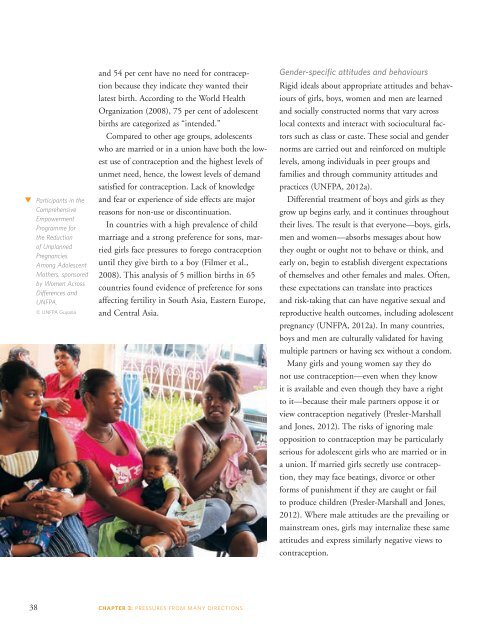Motherhood in Childhood
You also want an ePaper? Increase the reach of your titles
YUMPU automatically turns print PDFs into web optimized ePapers that Google loves.
t Participants <strong>in</strong> the<br />
Comprehensive<br />
Empowerment<br />
Programme for<br />
the Reduction<br />
of Unplanned<br />
Pregnancies<br />
Among Adolescent<br />
Mothers, sponsored<br />
by Women Across<br />
Differences and<br />
UNFPA.<br />
© UNFPA Guyana<br />
and 54 per cent have no need for contraception<br />
because they <strong>in</strong>dicate they wanted their<br />
latest birth. Accord<strong>in</strong>g to the World Health<br />
Organization (2008), 75 per cent of adolescent<br />
births are categorized as “<strong>in</strong>tended.”<br />
Compared to other age groups, adolescents<br />
who are married or <strong>in</strong> a union have both the lowest<br />
use of contraception and the highest levels of<br />
unmet need, hence, the lowest levels of demand<br />
satisfied for contraception. Lack of knowledge<br />
and fear or experience of side effects are major<br />
reasons for non-use or discont<strong>in</strong>uation.<br />
In countries with a high prevalence of child<br />
marriage and a strong preference for sons, married<br />
girls face pressures to forego contraception<br />
until they give birth to a boy (Filmer et al.,<br />
2008). This analysis of 5 million births <strong>in</strong> 65<br />
countries found evidence of preference for sons<br />
affect<strong>in</strong>g fertility <strong>in</strong> South Asia, Eastern Europe,<br />
and Central Asia.<br />
Gender-specific attitudes and behaviours<br />
Rigid ideals about appropriate attitudes and behaviours<br />
of girls, boys, women and men are learned<br />
and socially constructed norms that vary across<br />
local contexts and <strong>in</strong>teract with sociocultural factors<br />
such as class or caste. These social and gender<br />
norms are carried out and re<strong>in</strong>forced on multiple<br />
levels, among <strong>in</strong>dividuals <strong>in</strong> peer groups and<br />
families and through community attitudes and<br />
practices (UNFPA, 2012a).<br />
Differential treatment of boys and girls as they<br />
grow up beg<strong>in</strong>s early, and it cont<strong>in</strong>ues throughout<br />
their lives. The result is that everyone—boys, girls,<br />
men and women—absorbs messages about how<br />
they ought or ought not to behave or th<strong>in</strong>k, and<br />
early on, beg<strong>in</strong> to establish divergent expectations<br />
of themselves and other females and males. Often,<br />
these expectations can translate <strong>in</strong>to practices<br />
and risk-tak<strong>in</strong>g that can have negative sexual and<br />
reproductive health outcomes, <strong>in</strong>clud<strong>in</strong>g adolescent<br />
pregnancy (UNFPA, 2012a). In many countries,<br />
boys and men are culturally validated for hav<strong>in</strong>g<br />
multiple partners or hav<strong>in</strong>g sex without a condom.<br />
Many girls and young women say they do<br />
not use contraception—even when they know<br />
it is available and even though they have a right<br />
to it—because their male partners oppose it or<br />
view contraception negatively (Presler-Marshall<br />
and Jones, 2012). The risks of ignor<strong>in</strong>g male<br />
opposition to contraception may be particularly<br />
serious for adolescent girls who are married or <strong>in</strong><br />
a union. If married girls secretly use contraception,<br />
they may face beat<strong>in</strong>gs, divorce or other<br />
forms of punishment if they are caught or fail<br />
to produce children (Presler-Marshall and Jones,<br />
2012). Where male attitudes are the prevail<strong>in</strong>g or<br />
ma<strong>in</strong>stream ones, girls may <strong>in</strong>ternalize these same<br />
attitudes and express similarly negative views to<br />
contraception.<br />
38 CHAPTER 3: PRESSURES FROM MANY DIRECTIONS

















